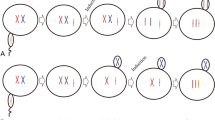Abstract
In this study, we trialed 6-dimethylaminopurine (6-DMAP) chemical shocks to induce meiosis I or meiosis II Pacific White shrimp, Litopenaeus vannamei, triploids for the first time, and cold temperature shocks to induce meiosis II L. vannamei triploids as done previously. Inductions were performed on 37 spawnings in total with experiments being progressively designed in a factorial manner to allow optimization of induction parameters. Treatment with a 200-μm 6-DMAP final concentration at 1 min post-spawning detection for a 6 to 8 min duration resulted in the most consistent induction of chemically induced meiosis I triploids while treatment at 7 min 30 s post-spawning detection for a 10-min duration resulted in the most consistent induction of chemically induced meiosis II triploids. A cold temperature shock of 11.7°C to 13.25°C (final treatment temperature; spawning water temperature 28.5°C) applied at 8 min post-spawning detection for a 4 to 10 min duration resulted in the most consistent induction of cold-temperature-induced meiosis II triploids. 6-DMAP shocks resulted in meiosis I induction rates from 29% to 100% in unhatched embryos and 50% in nauplii, and meiosis II induction rates from 65% to 100% in unhatched embryos and 52% to 100% in nauplii. Cold shocks resulted in induction rates from 5% to 100% in unhatched embryos and nauplii. Confocal microscopy analysis of embryos revealed that there are major developmental abnormalities in a large proportion of later stage triploid L. vannamei embryos compared to their diploid sibling controls. Despite this, however, some triploid embryos did appear normal and both shock agents induced small numbers of viable triploid L. vannamei nauplii which were successfully reared to protozoeal stage 3 as confirmed by flow cytometry. Triploids beyond this life-history stage were not observed in the present study as confirmed by flow cytometry at mysis stages. This study adds to our knowledge base of triploid induction in L. vannamei and further highlights the inherent difficulties with triploid embryonic and larval viability in this species.


Similar content being viewed by others
References
Aloise DD, Maia-Lima FD, de Oliveira RM, Cabral TD, Molina WF (2011) Ploidy manipulation and polyploidy detection in the White shrimp Litopenaeus vannamei (Boone 1931) (Decapoda, Penaeidae). Mar Biotechnol 13(1):41–47
Arce SM, Moss SM, Argue BJ (2008) Artificial insemination and spawning of pacific white shrimp Litopenaeus vannamei: implications for a selective breeding program. UJNR Technical Report No 28:5–8
Coman FE, Norris BJ, Pendrey RC, Preston NP (2003) A simple spawning detection and alarm system for penaeid shrimp. Aquac Res 34:1359–1360
Dumas S, Campos-Ramos R (1999) Triploidy induction in the pacific white shrimp Litopenaeus vannamei (Boone). Aquac Res 30:621–624
Foote A, Sellars MJ, Coman G, Merritt D (2010) Cytological defects during embryogenesis in heat-induced tetraploid Kuruma shrimp Penaeus japonicus. Arthorpod Struct Dev 39(4):268–275
Garcina-Rivera C, Arredondo-Figueroa JL, Barriga-Sosa IA (2004) Optimisation of triploidy induction in the pacific white shrimp, Litopenaeus vannamei. J Appl Aquac 16:85–94
Pawlak JB, Sellars MJ, Wood A, Hertzler PL (2010) Cleavage and gastrulation in the Kuruma shrimp Penaeus (Marsupenaeus) japonicus (Bate): a revised cell lineage and identification of a presumptive germ cell marker. Dev Growth Differ 52:677–692
Sellars MJ, Degnan BM, Preston NP (2006) Production of triploid Kuruma prawn, Marsupenaeus (Penaeus) japonicus (Bate) nauplii through inhibition of polar body I, or polar body I and II extrusion using 6-dimethylaminopurine. Aquaculture 256:337–345
Sellars MJ, Wood A, Dixon TJ, Dierens LM, Coman GJ (2009) A comparison of heterozygosity, sex ratio and production traits in two classes of triploid Penaeus (Marsupenaeus) japonicus (Kuruma shrimp): polar body I vs II triploids. Aquaculture 296:207–212
Sellars MJ, Li F, Preston NP, Xiang J (2010) Penaeid shrimp polyploidy: global status and future direction. Aquaculture 310(1–2):1–7
Sellars MJ, Wood A, Murphy B, McCulloch RM, Preston NP (2012) Triploid black tiger shrimp (Penaeus monodon) performance from egg to harvest age. Aquaculture 324–325:242–249
Vaca AA, Alfaro J (2000) Ovarian maturation and spawning in the white shrimp, Penaeus vannamei, by serotonin injection. Aquaculture 182:373–385
Wood AT, Coman GJ, Foote AR, Sellars MJ (2011) Triploid induction of black tiger shrimp, Penaeus monodon (Fabricus) using cold shock. Aquac Res 42(11):1741–1744
Wyban JA, Sweeney JN (1991) Intensive shrimp production technology: the oceanic institute shrimp manual. The Oceanic Institute, Honolulu
Acknowledgments
The authors would like to thank Bob Cartell, Starr Kapau, and Scott Naguwa from The Oceanic Institute for their assistance with spawning system set-up and animal handling, and Karen Selph at the University of Hawaii for her contributions to ploidy analysis. This project was funded through the Australian Academy of Sciences International Science Linkages program, Scientific Visits to North America and the CSIRO Food Futures National Research Flagship.
Author information
Authors and Affiliations
Corresponding author
Rights and permissions
About this article
Cite this article
Sellars, M.J., Arce, S.M. & Hertzler, P.L. Triploidy Induction in the Pacific White Shrimp Litopenaeus vannamei: An Assessment of Induction Agents and Parameters, Embryo Viability, and Early Larval Survival. Mar Biotechnol 14, 740–751 (2012). https://doi.org/10.1007/s10126-012-9439-2
Received:
Accepted:
Published:
Issue Date:
DOI: https://doi.org/10.1007/s10126-012-9439-2




